#427ci V8
Text


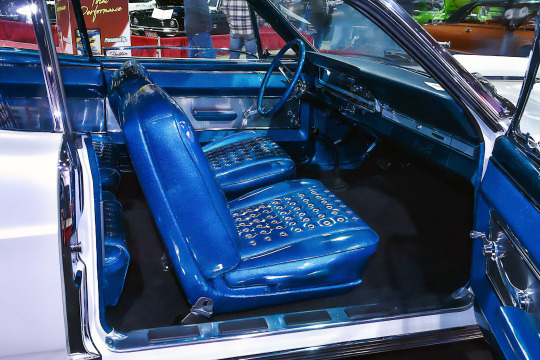
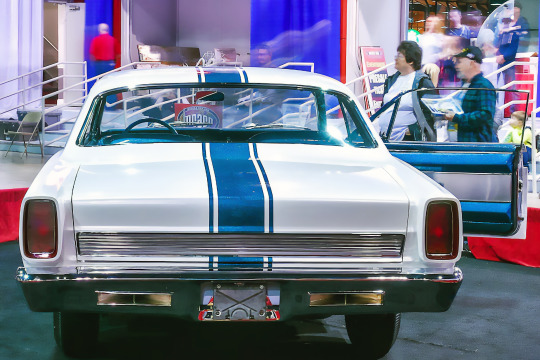
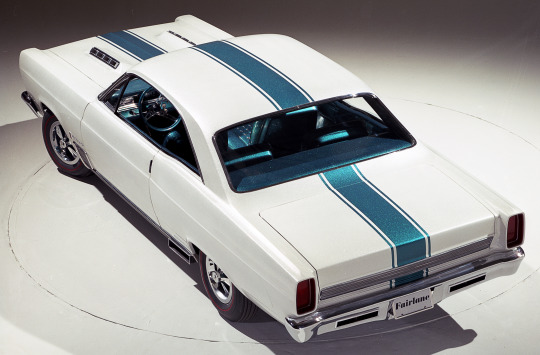
Ford Fairlane GT-X Concept, 1966. A prototype high performance version of the 5th generation Fairlane Hardtop that was prepared by Gene Winfield. It was powered by a 427ci side-oiler medium-riser V8, finished in pearl white with metallic blue pearl stripes and fitted with metallic blue Naugahyde bucket seats. It debuted in January 1966 at the Detroit Autorama and toured until early 1967. Like many Ford concepts of the 1960s the car was thought to have destroyed at the end of its show life. However it resurfaced in 2000 and has been restored back to its original condition.
#Ford#Ford Fairlane GT-X#concept#prototype#5th Generation#427ci V8#muscle car#custom car#Gene Winfield#one-off#restoration#show car#pillarless hardtop#pillarless coupe
875 notes
·
View notes
Photo

1966 Shelby 427 Cobra - Just sold for $1,705,000 - 12 of 50
14 notes
·
View notes
Text

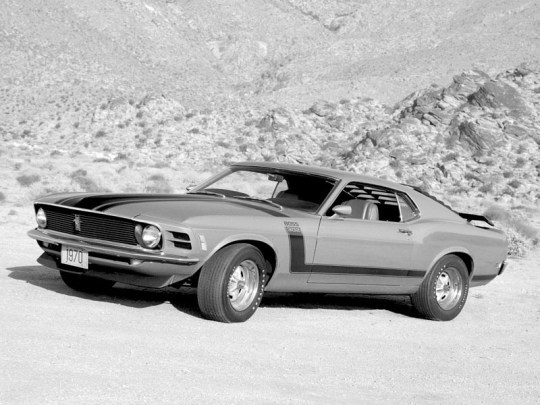
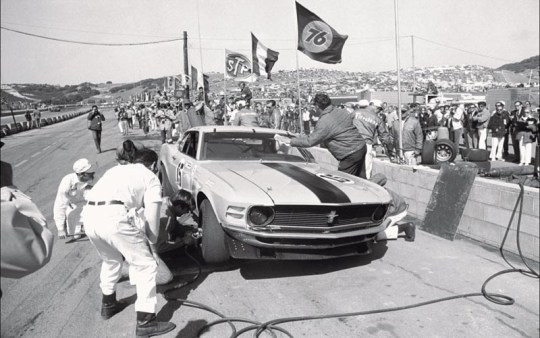
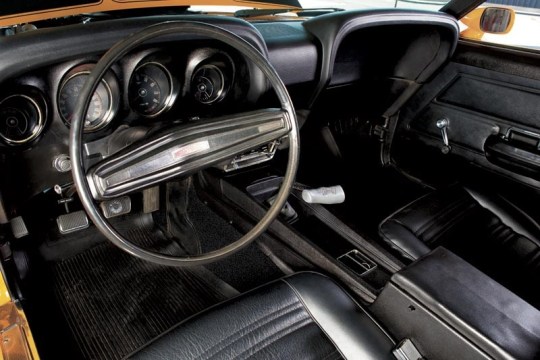
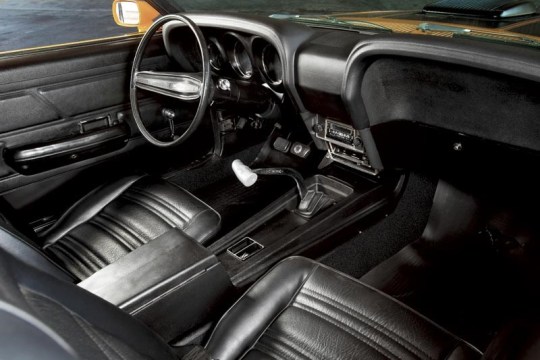



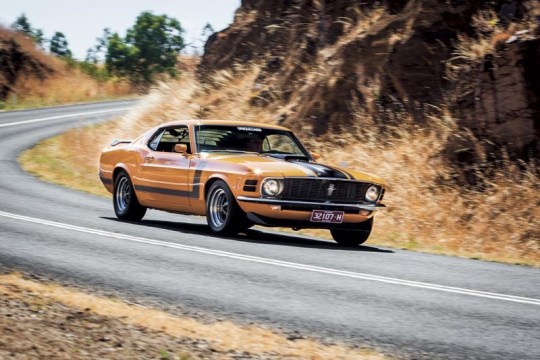

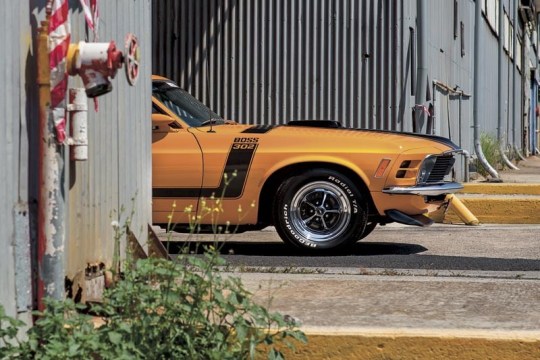
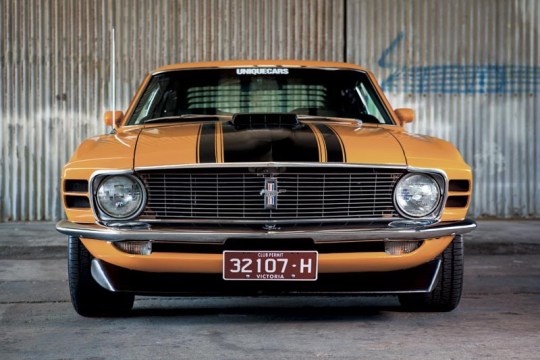

FORD MUSTANG BOSS 302
BOSS-A-NOVA!
They called it The Boss and for two short years it ruled the muscle car scene in the US, establishing itself as one of the greatest road and race cars of the era. Now, it’s one of the most collectible.
In 1960s US street lingo, if something was ‘boss’ it was cool, tough, the best. And the 1969 Boss 302 Mustang wore its badge with pride. It launched just four and a half years after the first Mustang was revealed to critical acclaim and record sales. Yearly updates to keep Mustang fresh in the face of tough new challengers from General Motors and Chrysler (particularly the Camaro) resulted in the once lean and pretty ’Stang muscling up, both in body shape and under-bonnet brawn, and the 1969-70 Boss models were the zenith of Mustang styling.
Thereafter, Mustangs became increasingly bloated and anaemic as the 1970s fuel crisis and stricter pollution laws cut horsepower and stylists lost their way; the rippling flanks and thrusting nose of the late 60s/early 70s cars gave way to boxy, bland designs. That early look would not be recaptured until 2005, when new Mustangs were given retro styling.
The Boss 302 was launched at the same time as its big-block brother, the Boss 429. Both were positioned as competition specials; Ford wanted to homologate its 302-cuber for Trans-Am and the 429ci monster for NASCAR. In fact, Ford went wild with engines between 1969-70, offering nine V8s – the ‘economy’ 302, 351 Windsor, 351 Cleveland, 390, 428 Cobra Jet, 428 Super Cobra Jet, 429 ‘wedge’, Boss 302 and Boss 429.
For the Boss 302, Ford’s high-compression 302ci small-block V8 was beefed up with four-bolt main bearing caps and redesigned ‘Cleveland’ cylinder heads with bigger inlet and exhaust valves, and ports that allowed the engine to breathe more efficiently.
These ‘semi-hemi’ heads were based on the Ford 427ci racing engine’s combustion chambers, and a balanced forged steel crankshaft and forged steel conrods allowed the engine to handle high rpms for sustained periods. A single 780cfm four-barrel Holley carburettor sat atop a high-rise aluminium inlet manifold, while a dual-point distributor, high-pressure oil pump, windage tray and screw-in welch plugs were further indications of its competition intent.
A rev limiter was fitted, progressively cutting spark from 5800rpm to 6150, but it was easily bypassed and the Boss 302 could reportedly keep making power up to 8000rpm with minor mods. In the muscle car marketing war, Ford claimed a peak horsepower figure of 290bhp at 5800rpm (the same as the Camaro Z/28), but that was extremely conservative.
Two four-speed manual Top Loader transmissions were available: a wide-ratio ’box with Hurst shifter more suited to street and strip use, and a close-ratio unit for racing. Adding to the race or road options list were four diffs: the stock 3.5:1 nine-inch, Traction-Lok 3.5:1 and 3.91:1 and the No-Spin 4.30:1 built by Detroit Automotive. Axles and diff centres were also strengthened to take the loads.
Suspension was also race-inspired with heavy-duty springs, shocks and sway bar up front, and Hotchkiss-style rear suspension with heavy-duty leaf springs, sway bar and staggered shock absorbers. The left-hand shock absorber was bolted behind the axle and the right in front, to reduce axle tramp under acceleration. Amazingly for such a high-performance car, braking was still only discs and drums with power assistance.
Ironically, the Boss 302’s sexy shape was styled by former General Motors designer Larry Shinoda, who is often credited with coming up with the Boss moniker. When asked what he was working on, he replied, "The boss’s car", a reference to new Ford president ‘Bunkie’ Knudson, who was also ex-GM and had recruited Shinoda to Ford.
While the wheelbase remained unchanged at 2740mm, the ’69 Mustang was 96.5mm longer overall to accommodate all the V8s offered, although the big-blocks still had to be shoe-horned under the bonnet. Shinoda’s ’69 Boss 302 was also one of the first production cars to offer an optional front air dam and adjustable rear wing, and his use of high-contrast black panels, rear window SportsSlats, and go-faster stripes made the Boss a real attention-grabber. The ’69 was also the only quad-headlight Mustang, a feature that was dropped for 1970 models.
In 1970, American Hot Rod magazine dubbed the 1970 Boss 302 as "definitely the best handling car Ford has ever built", while the conservative Consumer Guide called it "uncomfortable at any speed over anything but the smoothest surface". Unique Cars resident Mustang maniac, ‘Uncle’ Phil Walker, never read the Consumer Guide review, but even if he had it wouldn’t have stopped him buying the immaculate 1970 Grabber Orange Boss 302 you see here.
Phil already has his beloved 1966 Shelby GT350H, but the Boss 302 really got his Mustang juices percolating. And he wasn’t alone, because the first Boss he saw, some 43 years ago, is still one of Australia’s most iconic race cars: Allan Moffat’s Trans-Am racer. Phil remembers it clearly.
"I saw Moff race it Calder and I was inspired to own one," Phil recalls. "It was the most aggressive-looking car; its stance was something you had to see to believe. It looked like it was doing a million miles per hour when it was parked.
"My Boss was originally a one-owner car and I bought it from a friend of mine in California, Dave, who I also bought my Shelby GT350H from 19 years ago. Dave found it in a barn with a blown engine, but in otherwise pretty good condition.
"The lady who owned it from new didn’t realise it had a high-compression engine and had run it on standard fuel. When it blew up she just parked it.
"Dave did a nut-and-bolt restoration over two years, then put it up on his hoist. He didn’t want to sell it, but I got my way in the end – unfortunately he had the last say on the price (laughs). I didn’t even bother to test drive it; I knew it was a good car. It had 21 (new) miles on the odo when I picked it up and only 54,000 miles in total."
Since then, Phil has only put a couple of hundred miles on the car, but that’s enough for him to have bonded with it.
"I’ve only had the Boss since January and it’s growing on me. It’s different to the Shelby. It’s bigger and very low.
"The engine is incredible. Dave is one of the best engine builders in California and when he rebuilt the 302 he changed the cam spec. US camshaft technology was okay in the 60s and 70s, but if you had a big-cam muscle car they wouldn’t idle and they were terrible for driving in cities.
"A proper Boss engine can rev to 8500rpm all day and for a V8 that’s pretty serious. But they’re not renowned for low-down torque; it starts coming on from 3500rpm. My car still has a solid-lifter cam, but it pulls like a train from 1200rpm in top gear and I can drive it around at 1500rpm in top all day.
"It’s got the four-speed close-ratio Top Loader with the long first gear and with a 3.7:1 rear end it does about 55-60mph (89-97km/h) in first gear. It bloody goes!"
Phil is a fussy bugger and his cars have to look just right, so Russell Stuckey from Stuckey Tyres has ordered him a set of genuine 15 x 8 Minilites from England to replace the standard Magnum 500s.
"I want it to look like the Parnelli Jones race car, and to get the stance I want it’s going to have 275/60s on the rear and 255/60s on the front. At the moment it’s a pretty car that is tough, but I want a tough car that looks tough. And that’s all I’m going to do to it."
After his first real fang in the Boss, Phil felt that his Shelby would be half a lap in front at the end of a 10-lap sprint at Sandown, but now thinks the Boss would be quicker. We might have to put both to the acid test one day. What do you mean "no way", Phil?
It was a nervous Phil who turned up at a Melbourne storage facility in January to pick up his new Boss 302. So nervous, in fact, that he took along Unique Cars art director Ange and a sturdy tow rope – just in case.
The storage people were even more apprehensive – they had been warned about just how anal he is with his cars, as he explains: "The lady there said, ‘You must be pretty fanatical because we’ve been given strict instructions that no one is to touch the car except you’." Fortunately, the car arrived in pristine condition.
"I was pretty excited, I’d been waiting for seven weeks," Phil laughs. "I took the car cover off it, fired it up, and it drove home like a brand new car. It was as good as I thought it would be. I spent the next three hours washing it."
Sounds like our Phil.
PARNELLI AND ME
Three years ago, my mate Dave and I were invited to a Trans-Am dinner at Portland International Raceway where Dave was racing his 1970 Trans-Am Boss 302 and I was crewing for him.
When we were driving there we noticed this black Mercedes following us. When we stopped it did too and this bloke got out and said, "I noticed you guys back at the hotel. You’re going to the Trans-Am dinner aren’t you? I’m lost." It was Parnelli Jones!
I jumped in with him and when we got there I ‘invited’ myself onto Parnelli’s table, which also included Pete Brock – the guy who designed the Shelby Daytona Coupe. There was I, Mr Nobody, with all these US racing heavies, but Parnelli was a real gentleman, not up himself in any way.
The next day they had free lap time at Portland and, when I saw Parnelli there with Ford’s new ‘Parnelli Jones’ Boss 302 tribute Mustang, I asked if there was any chance of a ride and he said jump in. We did 10 laps and the guy hadn’t lost any of his ability; my eyes were getting bigger and bigger coming into the corners.
It was a great experience that I’ll never forget. – PW
IT's MINE...
Moff’s Mustang is probably the most iconic Australian racecar and after seeing it I was inspired to own a Boss Mustang.
Then, about 25 years ago, I went to Pebble Beach in Monterey for the first time and saw a 1970 Grabber Orange Boss 302, which was the colour Parnelli Jones raced in Trans-Am. That day I knew I had to own a Boss. It was the car I’d always wanted after my Shelby, which was my lifelong dream car.
My Boss 302 is fully optioned, including the Shaker, extra side mirror, tacho and rear louvres, and it’s got a lot of wow factor. When you drive down the freeway, you get the thumbs-up from all sorts of different people. I think it’s the colour.
It’s closer to show standard than my Shelby. It’s got the paint marks on the tailshaft and all the little concours details, but I’m never going to show it; I’m not into that.
The 1969/70 body shape is still the best. Ford got it right then, but lost the plot after that and it’s reflected in their collectibility today. – PW
#car#cars#muscle car#american muscle#ford#FORD MUSTANG BOSS 302#ford mustang#boss 302#MUSTANG BOSS 302#mustang
149 notes
·
View notes
Text
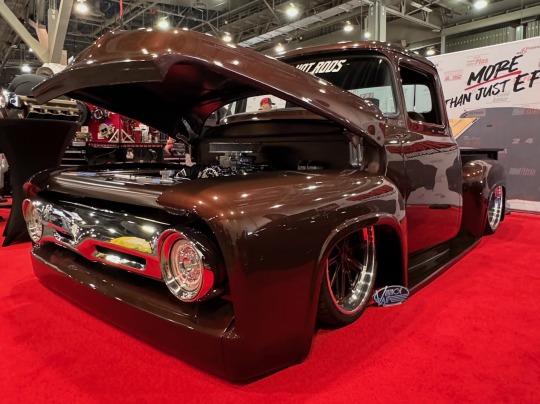
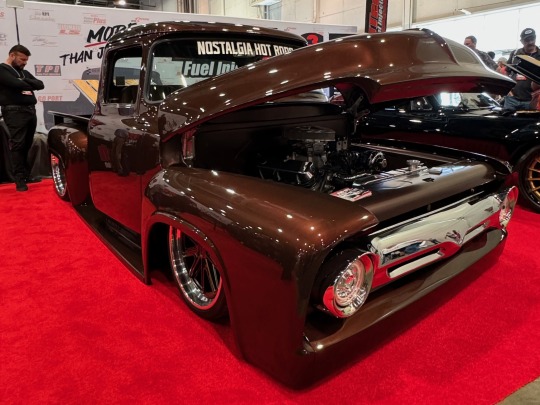
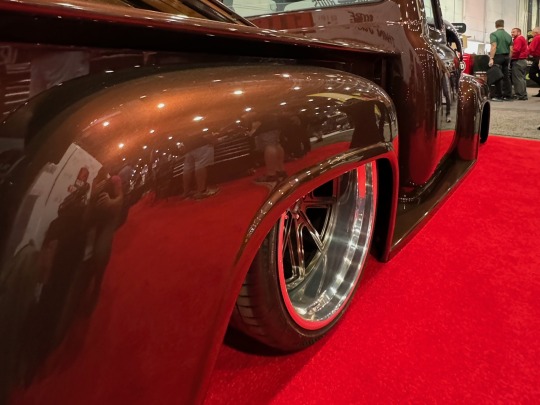

Mean Mug. The amazing "Mean Mug" 1956 Ford F100 was built by the team at Nostalgia Hot Rods and debuted in the FiTech booth, at the 2023 SEMA Show, where it won the AMD Garage Ford Truck of the Year award. It's powered by a 427ci FiTech-fuel injected Ford Performance small block V8 and rides on a custom Nostalgia Hot Rods-built chassis with air-ride suspension, Wilwood disc brakes, 245/30ZR20 & 285/30ZR22 Michelin tires, and 20x8.5/22x11 Forgeline forged three piece HL3X wheels finished with Satin Bronze centers & Polished outers! See more at: https://forgeline.com/customer-gallery/nostalgia-hot-rods
🇺🇸🇺🇸🇺🇸
#forgeline#forgelinewheels#forgedwheels#customwheels#HL3X#ForgelineHL3X#notjustanotherprettywheel#doyourhomework#madeinUSA#NolstalgiaHotRods#Ford#F100#56F100#SEMAShow#SEMA2023
56 notes
·
View notes
Text
The Anatomy of the 427 SOHC – Ford’s Answer to the HEMI that was banned from NASCAR and went drag racing.
What is the most feared engine ever to come out of Ford? A very subjective question – but the Boss 302, 427 Tunnel Port, Boss 429 come to mind. All these are candidates, but a lot of people would say that distinction belongs to the 427 SOHC. Mostly referred to as a 427 “Cammer” or “Sock”.
1964 was the year that Richard Petty won the Daytona 500 with the new Dodge 426 Hemi. Ford was running the 427 Hi-Riser that year and won the majority of NASCAR races. The writing was on the wall and the boys at Ford had to come up with an answer to the new Hemi. Within 90 days, Ford took what it learned from the 255ci Dual Overhead Cam Indy motor and applied it to the bulletproof 427ci FE motor. The displacements started at 332ci and grew to 428ci. The baddest of the bad of these were the 427’s and the King of the 427’s is the 427 SOHC!
The shortblock for the “cammer” was basically all 427 hi-riser. Ford wanted to keep the cost down by using as many off-the-shelf parts as it could. The crank was the 427 forged steel version that was cross-drilled at both the mains and rods. This crank with the steel hi-riser connecting rods and special “hemi-head” pistons was the ticket needed to live at 7500 rpms. Increased oil pressure and updated water pump helped to keep all fluids flowing no matter what the conditions were.
The main thing that drew your eyes to this motor was the massive valve covers, which were made from magnesium. One look and you knew that this was no ordinary engine. The heads were cast iron and wide. With a machined combustion chamber putting the compression ratio at 12.0:1. The intake ports were a “tunnel port” design that fed 2.25″ intake valves and through 1.90″ exhaust valves, gases exited out D shaped exhaust ports. Hollow stem intake valves were used and the exhaust valve stem were sodium filled to help control the heat that is generated at 7500 rpms.
The first public mention of the Cammer V8 appeared in the Daytona Beach Morning Journalon Feb. 23, 1964. Beaten up at Daytona all month by the new 426 Hemi engines from the Dodge/Plymouth camp, Ford officials asked NASCAR to approve an overhead-cam V8 the company had in the works. But as the Journal reports here, NASCAR boss Bill France turned thumbs down on Ford’s proposed engine. France regarded overhead cams and such to be European exotica, a poor fit with his down-home vision for Grand National stock car racing.
Even though France barred the SOHC V8 from NASCAR competition, Ford proceeded to develop the engine anyway, hoping to change Big Bill’s mind. In May of 1964, a ’64 Galaxie hardtop with a Cammer V8 installed was parked behind Gasoline Alley at the Indianapolis Motor Speedway, where the assembled press corps could get a good look at it.
On October 19, 1964, NASCAR moved to ban all “special racing engines,” in its words, eliminating both the Cammer Ford and the Chrysler 426 Hemi from Grand National competition for 1965. Chrysler responded by temporarily withdrawing from NASCAR, while Ford continued on with its conventional 427 pushrod engine in NASCAR and took the SOHC engine to the drag strips.
Despite heavy lobbying from Ford, in December of 1965 NASCAR again banned the Cammer for 1966, with USAC piling on (Spartanburg Herald-Journal, December 18, 1965 above). However, in April of 1966 NASCAR finally relented. Sort of. Okay, not really. The Cammer was now allowed, technically, but only in the full-size Galaxie model, limited to one small four-barrel carb, and with an absurd, crippling weight handicap: nearly 4400 lbs, 430 lbs more than the Dodge and Plymouth hemis. At that point Ford said no thanks and dedicated the Cammer to drag racing. The engine never turned a lap in NASCAR competition.
Ford made the Cammer widely available in the drag world, providing engine deals to nitro racers Tom Hoover, Pete Robinson, Connie Kallita, and a host of others. Among the most successful Cammer-equipped drag cars were the 1966-67 Comet flip-top funny cars (Don Nicholson, Eddie Schartman, et. al.) and Mickey Thompson’s dominating ’69 Mustang team starring Danny Ongais and Pat Foster.




9 notes
·
View notes
Text

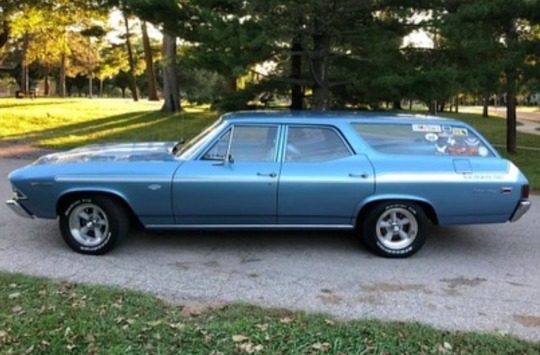
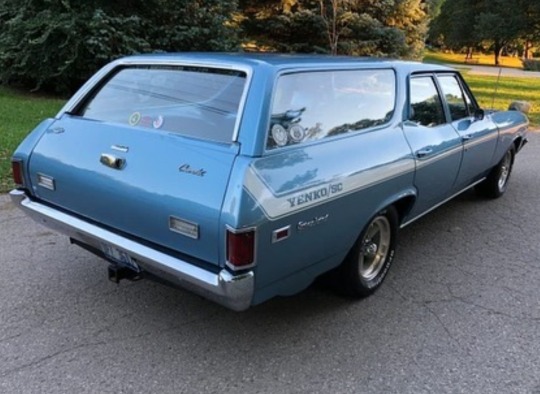
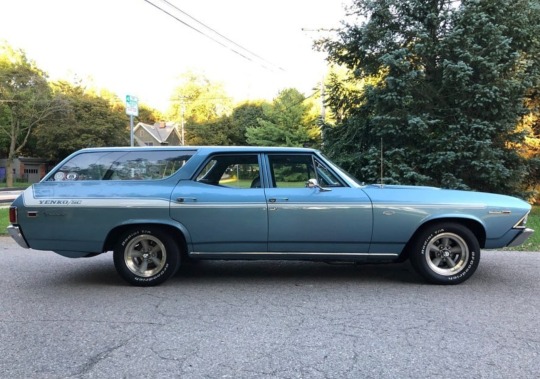





1969 Chevrolet Greenbrier Chevelle Wagon, sold new at Weber Chevrolet in Ackley, Iowa and is powered by a 427ci V8 backed by a Tremec 5-speed manual trans. Color is Glacier Blue over Blue vinyl.
7 notes
·
View notes
Photo

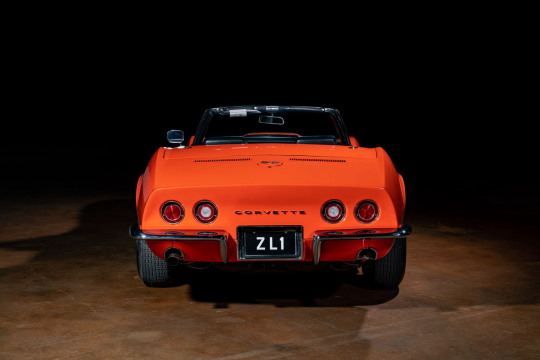







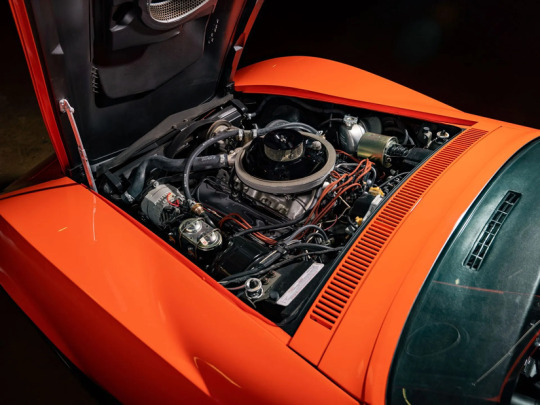
Chevrolet Corvette Stingray ZL-1 Convertible (1 of 1)
The Chevrolet Corvette is a historic car for a number of reasons but very few are as special as this 1969 example. It’s one of two factory-built aluminum 427 ZL-1 Corvettes ever made. And it’s the only one with a convertible drop top.1969 was a special year for the Corvette but even many die-hard Vette fans don’t know about this car. A very special factory option code, RPO ZL-1, cost $4,718 on its own and more than doubled the price of the car. For that hefty sum, the owner got a street-legal version of the 427ci all-aluminum V8 engine from CanAm racing under the hood.The resulting 560 hp (417 kW) is fed through an M40 automatic transmission and then straight to the rear wheels. This isn’t just a normal Corvette with a racing-related drivetrain though. The brakes and suspension were upgraded too. The car was stripped of creature comforts too. The radio, heater, AC, power windows, and power steering are all absent in the car.
18 notes
·
View notes
Text
Superformance MKIII 427ci 5-Speed $91,000
This Superformance MKIII was ordered new by the seller from Hillbank Motor Corporation of Irvine, California in 2006. Finished in black over black leather, the car is powered by a 427ci side-oiler V8 paired with a Tremec five-speed manual transmission. Voss Performance of Fullerton, California installed the powertrain as well as heavy-duty sway bars, and other equipment includes 15″ Halibrand-style wheels, Wilwood disc brakes, ceramic-coated side pipes, dual roll hoops, and a wood-rimmed steering wheel. The seller has added approximately 4,500 miles to the car, which has been issued SB100 smog exemption in California. This Shelby Cobra replica is now offered with a soft top, a tonneau cover, a car cover, a hammer, a fire extinguisher, a build sheet, service records, and a clean California title that describes the car as a specially constructed vehicle with no model year.
The car was custom-ordered in black and finished in PPG materials using a two-stage process. Features include dual chrome-finished roll hoops, ceramic-coated side pipes, and a locking hood, trunk, and gas cap. The seller notes stone chips on the lower area of the nose, and the paintwork and exterior trim are shown up close in the photo gallery below.
Polished aluminum 15″ Halibrand-style wheels are mounted with three-ear knockoffs that have been safety wired. They are shod in 255/60 front and 295/50 rear BFGoodrich Radial T/A tires, and each corner is equipped with Wilwood disc brakes. The car also features a coilover suspension, and Voss Performance installed larger heavy-duty sway bars front and rear.
The interior features bucket seats with black leather upholstery and upper harnesses that were added to integrate with the latch-locking lap belts. The glovebox is lockable, and the battery as well as an electrical disconnect switch are located in the trunk.
A wood-rimmed steering wheel frames Smiths instrumentation that includes a reverse-sweep 180-mph speedometer, an 8k-rpm tachometer, auxiliary gauges, and a Lucas ammeter.
The 427ci side-oiler V8 was initially built by JMS Racing Engines of Monrovia, California and installed by Voss Performance. In 2008 the engine was rebuilt, serviced and tuned by RC Performance of Huntington Beach, California, at which time dynamometer results indicated that the engine produced a peak output of 465 horsepower and 493 lb-ft of torque at the crankshaft. Features include a forged crank, Ross pistons, cast-iron cylinder heads with Shelby American roller rocker arms, an Isky Racing Cams camshaft, a mechanical MSD distributor, a Canton Racing Products oil pan, ceramic-coated headers, and dual-quad Edelbrock 600-cfm carburetors mounted to a Ford Racing mid-rise intake manifold. The seller notes that the oil was changed in preparation for the sale and that the solid-lifter valves should be adjusted in approximately 800 miles.
Power is delivered to the rear wheels through a Tremec TKO-600 five-speed manual transmission. The rear differential features a 3.73:1 final-drive ratio, and additional photos of the underside are presented in the gallery.
1 note
·
View note
Text

Super nice Galaxie 500 that I spotted at this weekend's car show. I wonder what size engine it has in it? (That was sarcasm.)
19 notes
·
View notes
Photo

The best Cobra. Shelby Cobra 427 S/C
86 notes
·
View notes
Text





Nichols N1A, 2023. A project by a former McLaren designer to create a Can‑Am inspired road car styled after the McLaren M1A, the first sportscar designed and built by Bruce McLaren’s racing team. An initial run of 17 launch-spec cars will feature a dry-sump 7.0-litre-develop of the GM LS3. These new blocks have been bored out to their new 427ci capacity with steel liners and upgraded pistons, producing around 660PS. Each of these engines will be built by Langford Performance Engineering, a company that has produced F1 engines. All models will come with a six-speed manual gearbox. The graphene-infused carbon-fibre bodywork covering an aluminium and carbon-fibre chassis means very light 900kg weight and a 710PS per tonne power-to-weight ratio. Prices have yet to be confirmed but are said to be in the region of £450,000
#Nichols#Nichols N1A#McLaren M1A#replica#sports car#mid-engine#LS3 V8#427ci V8#lightweight#retro style#Can-Am#prototype#new cars
305 notes
·
View notes
Text
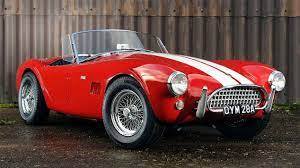
1963 AC SHELBY COBRA
1963 AC SHELBY COBRA 4.7-LITRE MARK II ROADSTER
REGISTRATION NO. OYM 28A
CHASSIS NO. CSK2116
ENGINE NO. CSX2116
Footnotes
Rightly regarded as one of the all-time great classic sports cars, the muscular, fire-breathing Cobra succeeded in capturing the hearts of enthusiasts like few of its contemporaries. Only 1,000-or-so Cobras of all types were built between 1962 and 1967, but such was the model's enduring popularity that production was resumed in 1982 under the auspices of Brooklands-based Autokraft.
Convinced that a market existed for an inexpensive sports car combining European chassis engineering and American V8 power, Le Mans-winning Texan racing driver Carroll Shelby concocted an unlikely alliance between AC Cars and the Ford Motor Company. The former's Ace provided the simple twin-tube chassis frame - designed by John Tojeiro - into which was persuaded one of Ford's lightweight, small-block V8s. It was discovered that the latter was lighter than the six-cylinder Ford Zephyr unit that AC was using, yet with vastly greater potential. To cope with the projected power increase, the Ace chassis was strengthened with heavier gauge tubing and supplied fitted with four-wheel disc brakes. Weighing a mere 1.5cwt more than a Bristol-engined Ace yet endowed with double the power and torque, the Cobra turned in a breathtaking performance, racing to 60mph in 4.4 seconds and reaching the 'ton' in under 12, exceptional figures by early 1960s standards and none too shabby even today.
The 260ci (4.2-litre) prototype first ran in January 1962, with production commencing later that year. Exclusively for the USA initially, Cobras - minus engines - were sent from England to be finished off by Shelby in California, and it was not until late in 1963 that AC Cars in Thames Ditton got around to building the first fully finished cars to European specification.
After 75 Cobras had been built with the 260ci engine, the more powerful 289ci (4.7-litre) unit was standardised in 1963. Rack-and-pinion steering was the major MkII up-date; then in 1965 a new, stronger, coil-suspended MkIII chassis was introduced to accommodate Ford's 427ci (7.0-litre) V8, an engine that in race trim was capable of producing well in excess of 400bhp. Wider bodywork, extended wheelarch flares and a bigger radiator intake combined to create the definitive - and much copied - Cobra MkIII look. Keeping ahead of the competition on the racetrack had been the spur behind Shelby's adoption of the 427 engine, but some MkIIIs to 'street' specification came with Ford's less powerful 428ci hydraulic-lifter V8.
But for Brian Angliss, the Cobra story would have ended in 1967. The Autokraft boss had built up a business restoring Cobras and supplying parts, and in the early 1980s acquired the rights to the AC name plus a quantity of jigs and tooling from the old Thames Ditton factory. Keeping the overall style of the MkIII, Autokraft produced the MkIV, which was appropriately updated to meet current legislation and powered by a 'Federalised' Ford 5.0-litre V8 engine. Around 480 were built.
Chassis number 'CSX2116' was invoiced to Shelby American on 16th April 1963 and shipped to Los Angeles three days later aboard the 'SS Loch Gowan'. Invoiced on 18th June 1963 to Burton Motors of Sacramento, California, the Cobra was sold new to a local doctor who used it for a few years before giving it to his daughter. She used the car as daily transport for several years before the clutch failed, at which time it was sold to Steve Dangremond of Santa Rosa, California. The Cobra was advertised for sale by Mr Dangremond in late 1977 and bought by Dr Grant Hill of Chotoka, Alberta. Dr Hill fitted Weber carburettors and raced 'CSX2116', eventually trading it to Fred Yule in Portland, Oregon. At that time, the car was still finished in its original colour scheme of dark blue and retained its original black leather interior.
'CSX2116' returned to the UK in the late 1980s and was advertised through Hampson's Ltd, by which time it had been refinished in red and fitted with a full-width roll bar. Subsequent owners in England were Dr Carlos Barbot, Trojan boss Peter Agg and Formula 1 racing driver Rupert Keegan. 'CSX2116' was last restored in 1988, records on file indicating that an extensive mechanical restoration was undertaken at this time. The car still retains its original black leather interior though the Weber carburettors have gone, replaced by an easier to maintain four-barrel Holley. There is considerable additional accompanying documentation including correspondence between previous owners, a copy of the original bill of sale, Shelby American Automobile Club letter of authentication, FIA papers and Swansea V5 registration document. The car has belonged to the current owner since 2006.
Early Cobras are offered for sale only rarely and this example represents a wonderful opportunity to acquire a fine example of this classic of Anglo-American sports car design.
90 notes
·
View notes
Photo
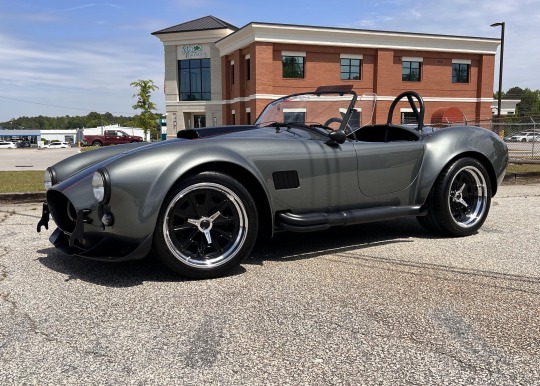



Visceral. This fiberglass-bodied Downforce Motorsports Superformance Cobra 427 Mk3 is powered by a 427ci Shelby V8 mated to a Tremec 5-speed manual transmission and rides on a TIG-welded ladder frame chassis with fully independent front & rear suspension, Wilwood disc brakes, Continental tires, and center-locking 18x9.5/18x11 Forgeline forged three piece HL3-CL wheel finished with Gloss Black centers & Polished outers! See more at: https://forgeline.com/customer-gallery/downforce-motorsports
🇺🇸🇺🇸🇺🇸
Forgeline formed in 1994 with the express purpose of manufacturing USA-made custom lightweight forged wheels for road racing applications. For 30 years since, we've built our reputation by engineering and manufacturing wheels that can withstand the extreme demands of sports car racing. With an unwavering commitment to strength, safety, and performance, we've earned our place on some of the world’s fastest track cars, including the factory-engineered Chevrolet C8 Corvette GT3.R, Chevrolet Camaro GT4.R, Ford Mustang GT4, and Hennessey Venom F5 Revolution. We continue to manufacture our forged wheels in Dayton, Ohio using exclusively U.S.-sourced parts, including our industry-leading APP aluminum forgings that meet the most stringent aerospace and defense industry specifications. Don't settle for anything less.
#forgeline#forgelinewheels#forgedwheels#customwheels#HL3#ForgelineHL3#centerlock#notjustanotherprettywheel#doyourhomework#madeinUSA#DownforceMotorsports#Cobra427#CobraMk3
20 notes
·
View notes
Photo

Superformance MKIII - 427ci Roush 427R V8 - Tremec five-speed manual - Dana limited-slip differential
2 notes
·
View notes
Text
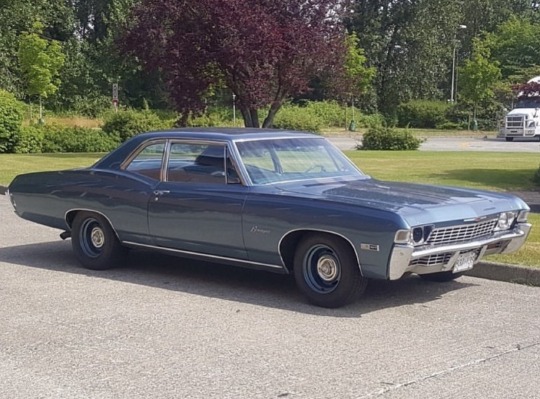

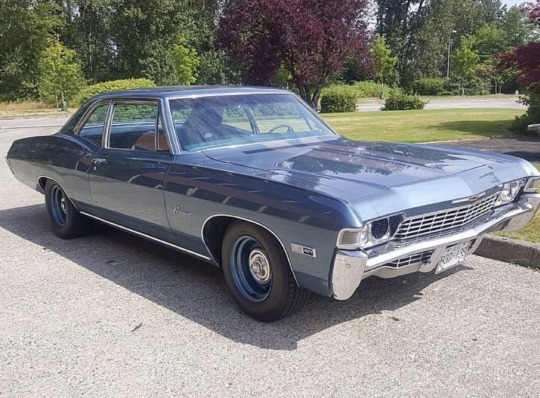


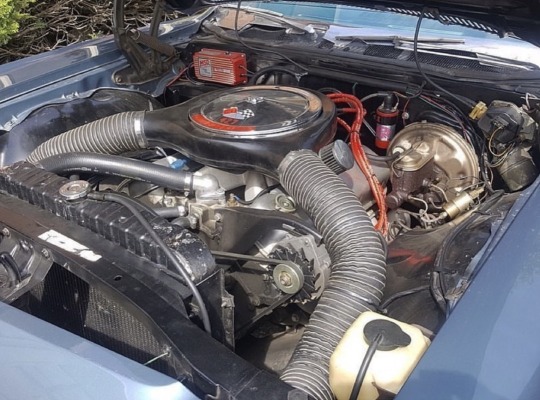
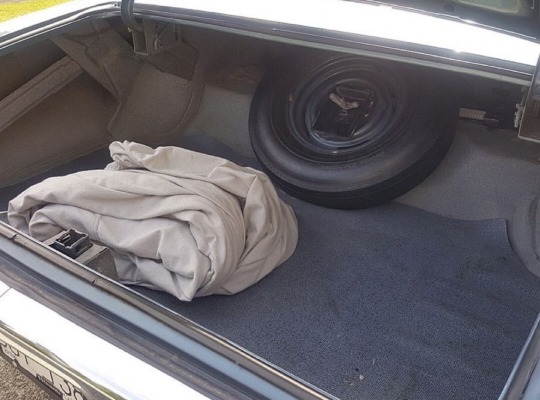
'68 Chevy Biscayne post car wearing the correct Blue w/subtle Gray SS striping, impeccable stainless trim. Stanced on deep color matched rallye wheels w/caps. A "healthy" 427ci big block V8, receiving cold air from the prior location of the high-beams is partnered up w/a Muncie 4spd manual trans, a 12bolt posi w/ 4:56 gears. A blue bench seat interior is very nostalgic w/radio delete, a Hurst equipped shifter on the floor, column mounted monster tach w/shift light & under-dash auxiliary gauges.
1 note
·
View note




